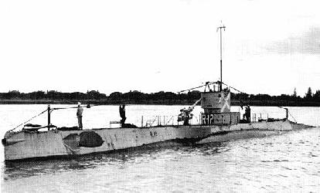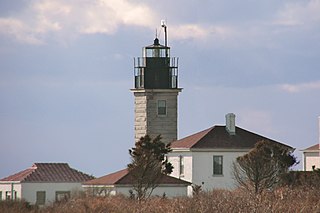
Scapa Flow is a body of water in the Orkney Islands, Scotland, sheltered by the islands of Mainland, Graemsay, Burray, South Ronaldsay and Hoy. Its sheltered waters have played an important role in travel, trade and conflict throughout the centuries. Vikings anchored their longships in Scapa Flow more than a thousand years ago. It was the United Kingdom's chief naval base during the First and Second World wars, but the facility was closed in 1956.
German submarine U-869 was a Type IXC/40 U-boat of the German Navy (Kriegsmarine) during World War II; her keel was laid down 5 April 1943 by Deutsche Schiff- und Maschinenbau AG Weser of Bremen. It was commissioned on 26 January 1944 with Kapitänleutnant Hellmut Neuerburg in command. Neuerburg went down with his boat. The wreck of U-869 was discovered off the coast of New Jersey in 1991.

USS R-12 (SS-89) was an R-class coastal and harbor defense submarine of the United States Navy.

Block Island is an island of the Outer Lands coastal archipelago, located approximately 9 miles (14 km) south of mainland Rhode Island and 14 miles (23 km) east of Long Island's Montauk Point. The island is coterminous with the town of New Shoreham, Rhode Island and is part of Washington County. The island is named after Dutch explorer Adriaen Block, and the town was named for Shoreham, Kent, in England.

USS G-1 (SS-19½) was the lead ship of her class of submarine of the United States Navy. While the four G-boats were nominally all of a class, they differed enough in significant details that they are sometimes considered to be four unique boats, each in a class by herself.

German submarine U-853 was a Type IXC/40 U-boat of Nazi Germany's Kriegsmarine during World War II. Her keel was laid down on 21 August 1942 by DeSchiMAG AG Weser of Bremen. She was commissioned on 25 June 1943 with Kapitänleutnant Helmut Sommer in command. U-853 saw action during the Battle of the Atlantic in World War II. She conducted three patrols, sinking two ships totalling 5,353 GRT and 430 tons.

USS Upshur (DD–144) was a Wickes-class destroyer in the United States Navy before and during World War II. She was the first ship named for Rear Admiral John Henry Upshur.

USS Charles H. Roan (DD-853) was a Gearing-class destroyer of the United States Navy. The ship was named after Charles Howard Roan, a United States Marine who lost his life in action on the island of Palau during World War II.

German submarine U-550 was a Type IXC/40 German Navy U-boat built during World War II. She was laid down on 2 October 1942 by Deutsche Werft in Hamburg as yard number 371, launched on 12 May 1943 and commissioned on 28 July under the command of Kapitänleutnant Klaus Hänert.

USS Atherton (DE-169), a Cannon-class destroyer escort, was the only ship of the United States Navy to be named for Lt. (jg) John McDougal Atherton, who died when USS Meredith sank near Guadalcanal during World War II.

German submarine U-1105, a Type VII-C/41 U-boat of Nazi Germany's Kriegsmarine, was built at the Nordseewerke Shipyard, Emden, Germany, and commissioned on 3 June 1944. Oberleutnant zur See Hans-Joachim Schwarz was given command. He would command U-1105 for the remainder of the war.

Beavertail Lighthouse was built in 1856 and is the premier lighthouse in Rhode Island, marking the entrance to Narragansett Bay. The 64-foot (20 m) lighthouse lies on the southernmost point of Conanicut Island in the town of Jamestown, Rhode Island in Beavertail State Park, on a site where beacons have stood since the early 18th century. The light provides navigation for boats and ships entering Narragansett Bay in the East Passage between Conanicut Island and Newport, Rhode Island on Aquidneck Island. Other lighthouses are visible from Beavertail Lighthouse, such as Castle Hill Lighthouse, Point Judith Light, and Rose Island Light.

USS Amick (DE-168) was a Cannon-class destroyer escort built for the United States Navy during World War II. She served in the Atlantic Ocean and then the Pacific Ocean and provided escort service against submarine and air attack for Navy vessels and convoys.
Point Judith Pond is a shallow, four-mile (6 km)-long salt body of water lying behind the barrier beaches and sand dunes that form Point Judith Harbor, which lies immediately west of Point Judith in Narragansett, Rhode Island at the southwestern tip of Narragansett Bay. Located about 14 miles (23 km) southwest of Newport Harbor, Point Judith Pond forms a partial border between the communities of Narragansett and South Kingstown, and is connected to Point Judith Harbor by a narrow waterway that cuts through the beaches and sandy shoreline. This waterway is used by a large fishing fleet and local and transient recreational craft. The harbor handles a large amount of passenger traffic, primarily during the summer. Year-round ferry service is available between Point Judith and Block Island.

USS Eagle 56 (PE-56) was a United States Navy World War I-era patrol boat that remained in service through World War II. On 23 April 1945, while towing targets for U.S. Navy bomber exercises off the coast of Maine, Eagle 56 was sunk by the German submarine U-853. Only 13 of the 62 crew survived.
The last actions of the Battle of the Atlantic in American waters took place on 5–6 May 1945. There were two such actions, against U-853 off the Rhode Island coast and U-881, south of Cape Race, both sunk during the same period.

Galilee is a fishing village on Point Judith within the town of Narragansett, Rhode Island, USA, and is notable for being home to the largest fishing fleet in Rhode Island and for being the site of the Block Island Ferry. The village is directly across the harbor from Jerusalem, Rhode Island. Galilee, Rhode Island is named after the Biblical Galilee, which was the original home region of Jesus Christ, who grew up in Nazareth, a village in the Galilee region of Israel on the Sea of Galilee. Four of Jesus' disciples, Andrew, Peter, James and John, were fishermen from Galilee.

The Battle of Point Judith is the popular name for a naval engagement fought between the United States and Nazi Germany during World War II on May 5 and 6, 1945 - with Germany on the verge of total defeat and surrender, and Hitler having already died by suicide. American surface combatants and two blimps sank a German U-boat off Point Judith, Rhode Island in one of the last actions of the Battle of the Atlantic. The SS Black Point a 368-foot, 7,500-ton coal ship, was sunk at the start of the Battle.

Camp Varnum is a Rhode Island Army National Guard training facility in the Boston Neck area of Narragansett, Rhode Island. During World War II it was Fort Varnum, a coastal defense fort.
The 243rd Coast Artillery Regiment was a Coast Artillery Corps regiment in the Rhode Island National Guard. It garrisoned the Harbor Defenses of Narragansett Bay, Rhode Island 1924–1944.




















